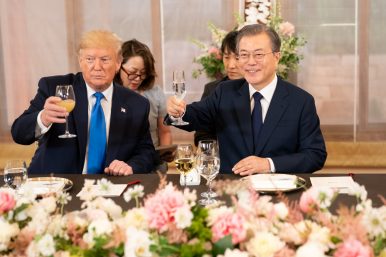By Ankit Panda
 The bilateral outcomes of U.S. President Donald J. Trump’s visit to South Korea at the end of June were largely overshadowed by the headline-grabbing sudden U.S.-North Korea summit meeting at the inter-Korean Demilitarized Zone.
The bilateral outcomes of U.S. President Donald J. Trump’s visit to South Korea at the end of June were largely overshadowed by the headline-grabbing sudden U.S.-North Korea summit meeting at the inter-Korean Demilitarized Zone.
Trump and South Korean President Moon Jae-in, however, discussed a range of issues in the context of the bilateral relationship. One of the less noticed outcomes was a rare acknowledgement by Moon of the U.S. Indo-Pacific strategy.
“Under the regional cooperation principles of openness, inclusiveness and transparency, we have agreed to put forth harmonious cooperation between Korea’s New Southern Policy and the United States’ Indo-Pacific Strategy,” Moon said at his press conference with Trump following their one-on-one talks on bilateral and regional issues.
Over the last 18 months, the United States has sought endorsements from allies and partners for its initiatives to support a so-called free and open Indo-Pacific. The concept is the successor to the Obama administration’s “rebalance” or “pivot” to Asia, with a greater focus on the preservation of a normative regional status quo in Asia.
In June, the U.S. Department of Defense unveiled a new strategic document, the Indo-Pacific Strategy Report, outlining a range of U.S. priorities in this strategic megaregion, which spans most of the Indian Ocean and the Pacific Ocean.
For South Korea under the progressive government of Moon, the concept of the Indo-Pacific hasn’t quite caught on. Where several U.S. partners and allies tacitly view endorsing the concept as acceptance of a containment agenda with regard to China, South Korea has been largely content to sit out on the sidelines.
For instance, in early June, at the Shangri-La Dialogue, a major regional defense forum, South Korean Defense Minister Jeong Kyeong-doo, in his plenary address, steered clear of the Indo-Pacific as a geographic concept or a strategy.
Moon’s latest acknowledgement, then, will turn heads in Washington. But, parsing the South Korean president’s words, what we find is less of a full-throated endorsement from Seoul, but more of an acknowledgement of what the United States is doing and possible complementarities between the Indo-Pacific strategy and initiatives South Korea already has underway.
The New Southern Policy has been a signature foreign policy initiative for the Moon administration, designed to better posture South Korea to avail itself of economic opportunities in Southeast Asia. As my colleague Prashanth Parameswaran has highlighted in more detail, the New Southern Policy is primarily an economic undertaking.
If there is a geopolitical or geoeconomic logic to South Korea’s interest in Southeast Asia, it is as an economic hedge to Seoul’s otherwise vast economic reliance on China. Seoul’s experience contending with China’s unofficial, but severe, economic sanctions after its acceptance of the U.S. Terminal High Altitude Area Defense missile defense system deployment in 2016 crystallized a sense of vulnerability.
What remains unclear for the moment is how exactly U.S. efforts under the Indo-Pacific strategy might find synergies with South Korea’s New Southern Policy. South Korea’s interest in the Indo-Pacific strategy may have been piqued, but Seoul is still keeping its participation in the broader U.S. regional effort at an arms’ length for the time being.
No comments:
Post a Comment